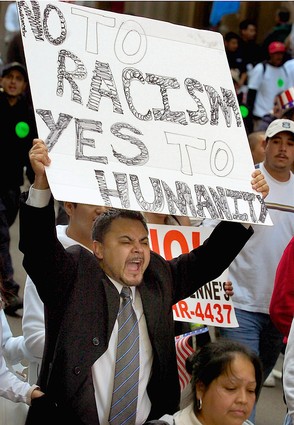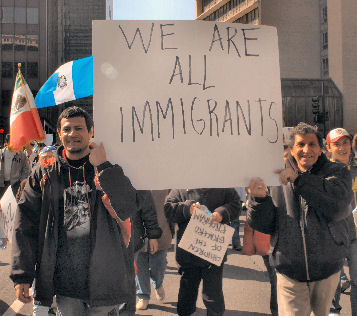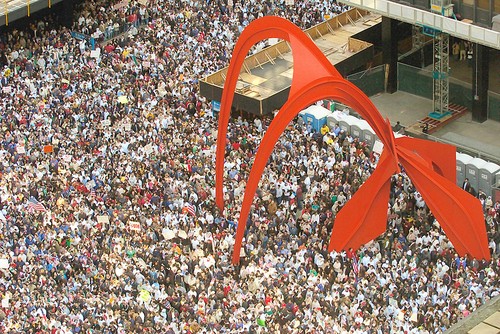March 11, 2006
Colleagues and friends:
I looked in vain this morning for an article in The New York Times covering
yesterday's human rights march in Chicago. And after I read the coverage in
Chicago's major daily newspapers, I've decided to share as much of my report as I
can widely today. I will also have photographs of the sea of human beings
that brought the central business and financial district of the third largest
city in the USA to a crawl yesterday. For now, I am too tired to add to the
information below, which I first sent along this morning to some friends.
I stayed on the ground throughout the march and walked more than four
miles yesterday in the course of covering it and taking photographs. The four
miles took more than four hours because Chicago yesterday was the scene of
one of the largest human rights marches in the history of this nation.
Although police ultimately estimated that 100,000 people marched in
Chicago yesterday, I think that estimate is low -- very low. My estimate,
based on careful review of all the information, most of which I saw with my own
eyes, is that between 180,000 and 250,000 people participated in the march
itself, and there could have been another 100,000 who came to the rally downtown
from other directions. I have photographs I took of a line of people filling
Jackson Boulevard heading east into the Chicago Loop, with the Sears Tower over
the whole scene. At the time I took that photograph, the marchers stretched
from curb to curb in the street and the line of marchers stretched for a mile
from the point where it turned east to the finish line in the federal plaza
downtown. But at that point there were still tens of thousands of people who had
not even begun to march, while tens of thousands of others were arriving from
the east, north and south into the Loop. By 3:00 yesterday afternoon, traffic
in Chicago's downtown had stopped. The streets of the downtown were filled
with people, not vehicles.
More about that later.
The most important thing to note about the march is that it was the
largest civil rights (or human rights) march in Chicago history and
that it was probably the largest march of any kind in Chicago history.
The only event that might compare took place last year to celebrate the
World Series victory of our (international) Chicago White Sox. And the
tone was the same.
When I arrived at Union Park -- the assembly point for the march, which was
supposed to step off at 1:00 p.m. for a downtown rally scheduled to begin at
2:00 p.m. -- at Lake and Ashland Ave. in Chicago yesterday at noon, at first it
looked like there was a small turnout.
The park itself was half empty. The reason the park was half empty,
however, was that the street west of the park was filled with people
for at least two miles, curb to curb, and the crowd kept growing. I
arrived by elevated train at about noon, and was able to take
photographs looking north and south from the elevated stairs so that I
have some photographs of the crowd from above. It was virtually
impossible to get shots from ground level that showed the vastness of
the crowd.
North from my first vantage point, the crowd stretched at least
three-quarters of a mile to Grand Ave. However, that was as far as I
could see, and people told me it actually filled the street as far
north as Chicago Ave. (one mile north of the city's east west axis) by
the time the march began moving towards the Loop (two miles to the
east) at 1:00. So there were a mile's worth of people north of the
center point before the march began.
But then I looked south, and the sea of people stretched even farther
to the south. I could only see as far south as the Congress Expressway
(I-90), which is raised. I was later told that the people arriving from
the south were walking up Ashland Ave. from 18th St. (one of Chicago's
traditional Mexican communities) and that what happened was that as
people got farther north it became impossible to walk on the sidewalks,
so people spilled into the streets until, at about Taylor St., the
police realized they had to close Ashland Ave because it was filled
with people. That was a mile south of where I was, so by the time the
march actually began, there were about two miles of people spread along
Ashland Ave. from roughtly Chicago Ave. on the north to Taylor St. on
the south. Anyone with a Chicago map can see the great distance this
was. Anyway, if you are using a map to share this, think of that entire
space filled with people so tightly that it was difficult to walk.
I finally headed west one block in order to get near the point where
the march turned east (at Jackson Blvd.). By the time I got to Jackson,
the march stretched east as far as the eye could see, and Ashland was
still filled and filling up even more.
My son Danny attends school at Whitney Young High School, a public
school, which is one block east of Ashland. The marchers were streaming
down Jackson towards the Sears Tower, which loomed on the horizon like
a beacon or compass point. Everyone was heading towards the tallest
building in Chicago (once in the world).
Whitney Young High School has an overpass above Jackson Blvd. under
which the crowd was streaming. I called my son Danny on his cell phone
and left a message that he should join me for the march, since
participation in it would be a better way to deal with government
(which he is studying in an AP class) and U.S. History (which he is
also studying) than sitting in a classroom. Then I went into Whitney
Young, where the principal and I talked and she agreed I could take my
son out on what is called an "early dismissal" for the march. I went up
to the walkway and took photogaphs of the sea of people strecthing west
and east from that point, and then went down and joined the march again.
About a half mile to the east, I stopped when Danny finally called me
back and waited for him to reach me. By that point, it was clear that
Chicago was experiencing its "Day without Mexicans." I saw men walking
out of buildings wearing custodial worker uniforms and other men and
women walking out of those expensive restaurants in Greek Town. I have
a hunch that the owners of some of Chicago's most expensive restaurants
had to bus their own tables yesterday, because the working people along
the line of march were leaving work to join the march. When Danny
caught up with me at Halsted St., still a mile from the site of the
rally, we talked about what was happening, and I pointed to those huge
buildings ahead of us, framed around the Sears Tower.
"If Chicago really had to face a day without the people we're marching
with, every toilet in every one of those buildings would clog up within
a day and the whole place would have to shut down within two days," was
one of the things I said. I just couldn't help thinking of how stupid
has been the narrative that puts a "CEO" at the center of every story
about this country today.
The march was a family affair. There were thousands of children, many
in arms, on shoulders, and in strollers. The youngest marchers were
only a few days old. The eldest, some in wheelchairs, were in their 70s
or older. But most of the marchers were that wonderful "demographic"
that marketing and political people talk about -- teenagers and young
adults in their prime. Hard working people. There were thousands of
teenagers marching arm in arm with their boyfriends and girlfriends. At
some points it was like that scene from "Close Encounters..." where
everyone is heading towards the same place, almost a vision.
There were banners and signs, but most people were simply walking.
Although American flags dominated, second among the flags were the
Mexican flag, followed by the flag of every nation south of the Rio
Grande River, and other flags including (I saw and recognized) Poland
and Ireland. Although the main language of the march was Spanish, if
you were listening closely you could hear many other languages as well.
Although the flag of Mexico was the most common, flags of other nations
were also everywhere. You could feel the combination of both flags --
the stars and stripes and the others --- as almost a human poem to what
we have built in this country, when this country at its best is before
us in our humanity.
I didn't have a radio, but was told that the Spanish radio and TV
stations were reporting continually on the march, and that people were
being told to join the march from school or work. It was clear that
students were walking out of perhaps a dozen Chicago high schools also
day. I don't have attendance figures yet, but teachers I met from one
high school (Senn, which has had the anit militarism struggles) said
"attendance is way down." Senn is about ten miles from the assembly
point of the march. A teacher from Gage Park High School (about eight
miles south of the march) said that her school began emptying out
around noon and continued to do so. Nearby schools (especially Benito
Juarez High School, which is on Ashhland Ave. two miles south of where
the march turned towards the Loop) were reportedly empty by lunch time.
When we got across the Chicago River and into the Loop, I saw something
I had never seen before. The Chicago Police had closed off six streets
to all but emergency traffic. Wells St., LaSalle St., Clark St.,
Dearborn St., and two smaller streets that run north to south were shut
down -- except for thousands of people walking on them -- from Adams
St. south to Congress, a distance of a bout a quarter mile. I took
pictures of each street filled with people and empty of cars, because
that is unprecedented, too.
I have to leave for a union meeting, but there are a couple of other
things I'd like to share.
If, as I suspect, a quarter million people marched in Chicago
yesterday, it was the most peaceful assembly of that many people in the
history of this city. Police reported that a couple of people were
arrested for graffiti. That's it. My estimate of the numbrs, which I'll
be revising, came after I tried to count the number in one block and
came up with "5,000 to 7,000" (curb to curb) in one Chicago block.
There are 16 blocks in a mile, and the front of the march was entering
the federal plaza by 2:00 p.m. while the tail of the march was still
stuck on Ashland Ave., two miles to the west, waiting to begin. But
people were also entering the march from all other points, not just
through the march itself.
There were dozens of songs. In federal plaza, a group of Mexican
dancers with huge Aztec feather headdresses danced the entire afternoon. I
thought if we had all planned better, it could have included Irish Dancers at
the same spot. And a polka.
All of the streets were packed so tightly that it was at times impossible
to move. Yet people were making sure to look for the little ones, who
generally didn't look frightened, even in the tightest crowd.
Because the Chicago Board of Education building sits right above the
federal plaza, I was able to talk my way into one of the south offices
towards the end of the march (about 4:30 p.m.) and take my last
photographs from 14 floors above Adams St.
For a time as I was walking along, choruses from and old union song --
Solidarity Forever -- kept going through my head:
"It is we who plowed the prairies, built the cities where they play,
Dug the mines and built the workshops, endless miles of railroad lay,
Now we stand outcast and starving midst the wonders we have made,
But the union makes us strong."
It was a day when all of us could be proud to be Americans and proud to
be truly for democracy. It was a day when the Plutocrats must have
trembled slightly after their years of lies and CEO worship, after
their foisting of stupid millionaires into the White House and
horrifying wars...
And so much more.
I'll share more as I find the time to work it up. I hope this -- one
narrative among thousands -- helps us build that counter narrative
we've talked about so long.
George N. Schmidt
Editor, Substance News
Csubstance@aol.com
5132 W. Berteau
Chicago, IL
60641-1440
ph: 773-725-7502
fax: 773-725-7503
http://www.substancenews.com/


